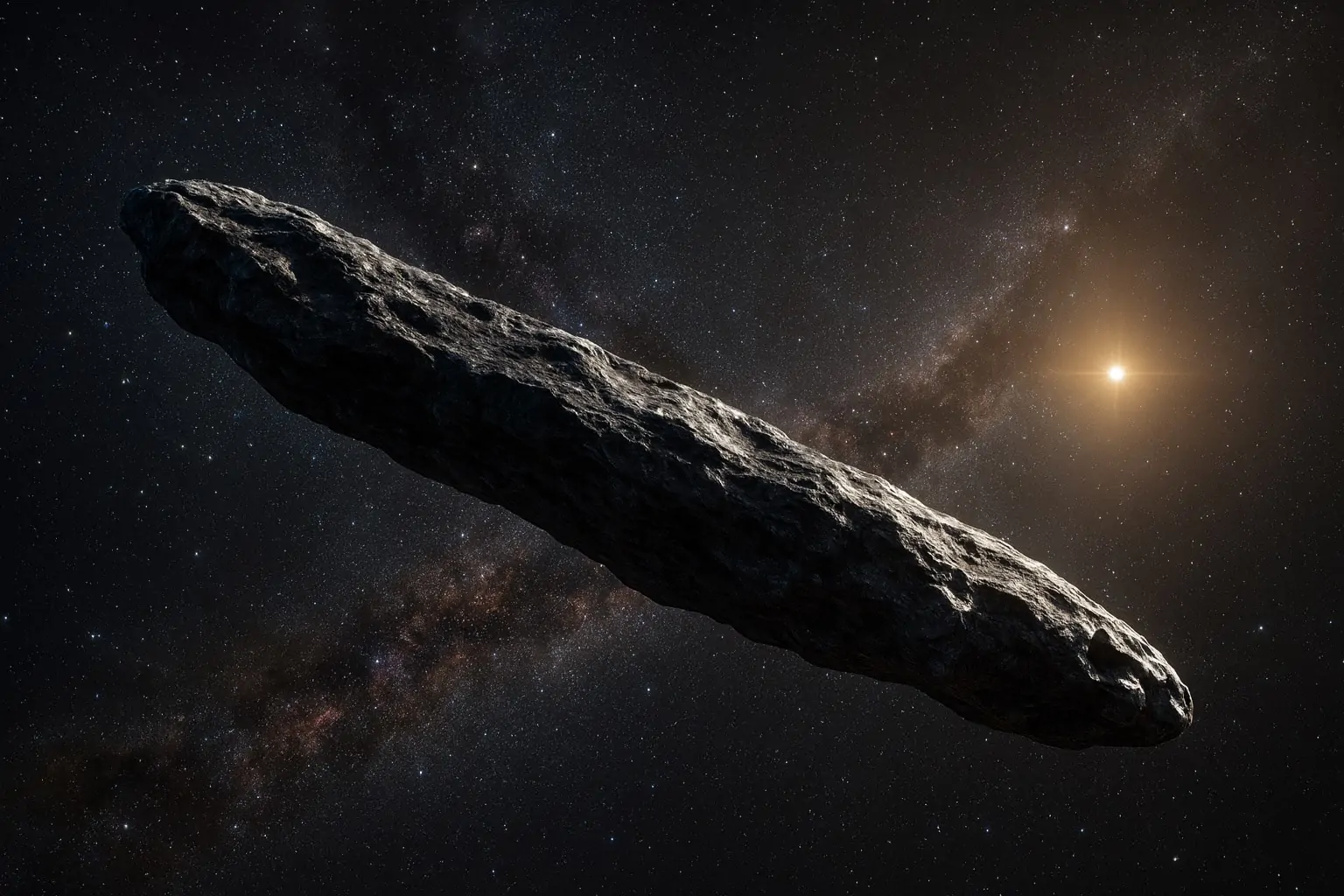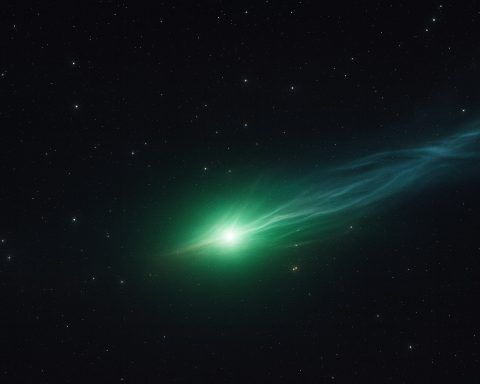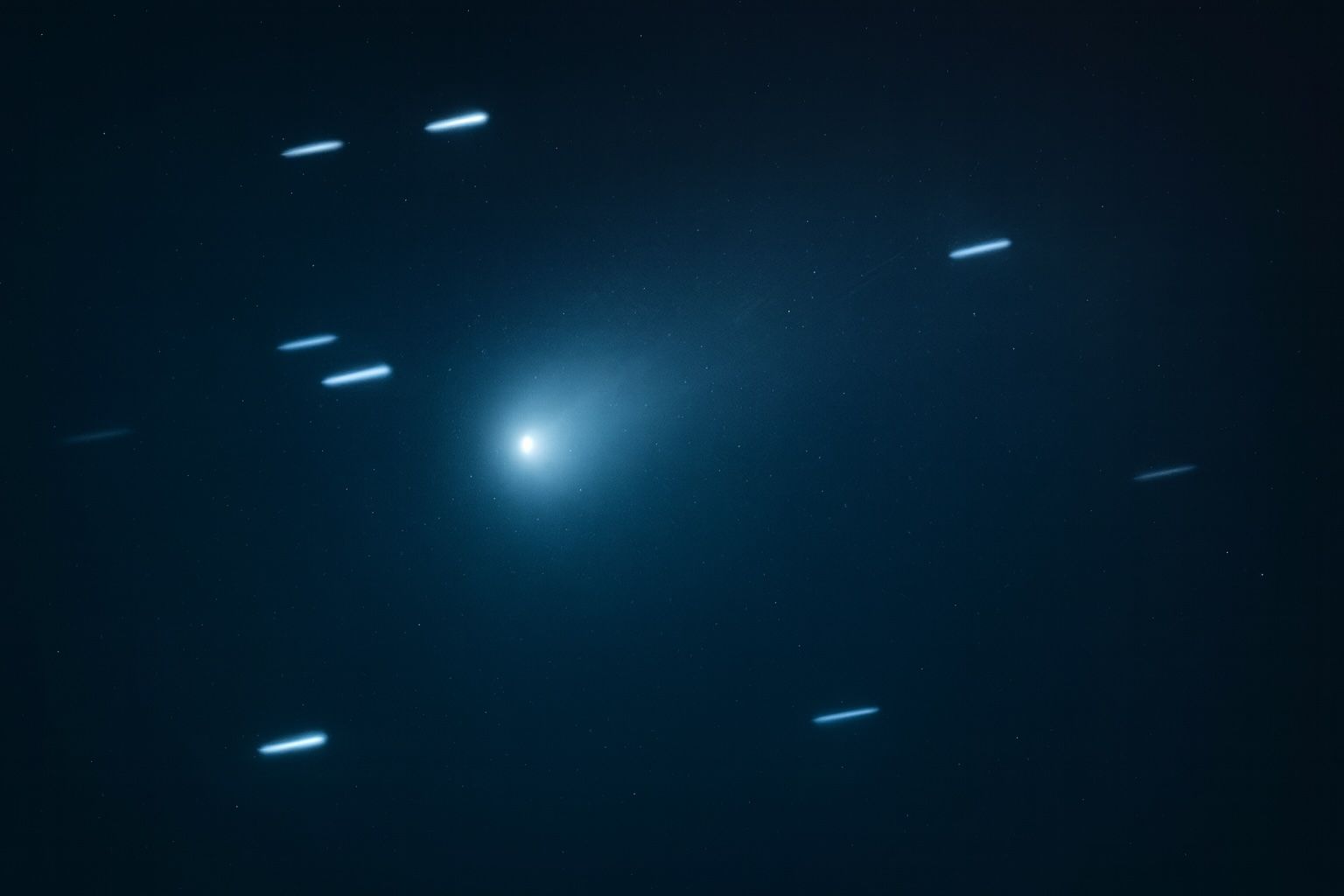Interstellar comet 3I/ATLAS (C/2025 N1 ATLAS) – a frozen wanderer from another star system – is back in the news today as space agencies and observatories around the world fine‑tune its trajectory, release new images and prepare global livestreams ahead of its safe flyby of Earth in December 2025.
At the same time, scientists are working hard to knock down viral claims that the comet is either an alien spacecraft or on a collision course with our planet. Spoiler: it’s neither.
Here’s what you need to know today.
What is 3I/ATLAS – and why is it such a big deal?
3I/ATLAS is only the third confirmed interstellar object ever seen passing through our solar system, after 1I/ʻOumuamua (2017) and 2I/Borisov (2019). It was first spotted on 1 July 2025 by the NASA‑funded ATLAS survey telescope in Río Hurtado, Chile, and later identified in “pre‑discovery” images going back to June. [1]
Key facts scientists agree on:
- Origin: Formed around another star and ejected into interstellar space long ago, arriving from the direction of the constellation Sagittarius. [2]
- Orbit: Follows a hyperbolic trajectory – it’s moving too fast to be captured by the Sun’s gravity, so it will visit once and then leave forever. [3]
- Size: The solid nucleus is estimated to be between 440 m and 5.6 km across. [4]
- Speed: Around 137,000 mph (221,000 km/h) when discovered, rising to about 153,000 mph (246,000 km/h) at closest approach to the Sun. [5]
- Closest to the Sun (perihelion):29–30 October 2025, at about 1.36–1.4 AU, just outside Mars’ orbit. [6]
Because it’s an active comet, 3I/ATLAS has grown a coma (a glowing gas cloud) and a long ion tail as sunlight heats its ices and drives jets of gas and dust into space. Recent images show that tail stretching at least 0.7° across the sky, along with a faint “anti‑tail” pointing the other way – an optical effect from our viewing angle. [7]
Today’s big development: ESA uses Mars to sharpen the comet’s path
One of the most important updates this week comes from the European Space Agency (ESA), which has dramatically improved predictions of 3I/ATLAS’s trajectory by using a spacecraft orbiting Mars.
Between 1 and 7 October 2025, ESA’s ExoMars Trace Gas Orbiter (TGO) turned its CaSSIS camera away from the Martian surface and toward the passing comet, which came within about 29 million km of Mars on 3 October. From that vantage point, TGO was roughly ten times closer to the comet than Earth-based telescopes and saw it from a completely different angle. [8]
By combining (triangulating) those Mars‑side observations with data from telescopes on Earth, ESA scientists:
- Improved the comet’s predicted position by a factor of 10, sharply reducing the “error bar” on its future locations
- Produced the first ever astrometric measurements from a spacecraft around another planet to be officially accepted into the Minor Planet Center’s global database
- Demonstrated a powerful new technique for planetary defence, even though 3I/ATLAS itself poses no threat [9]
This is essentially a real‑world rehearsal: if a genuinely hazardous object were discovered tomorrow, the same trick – pointing instruments on Mars‑orbiting or other planetary spacecraft at it – could help refine its orbit and sharpen impact‑risk calculations.
December 19: How close will 3I/ATLAS come to Earth?
A huge amount of the public interest (and anxiety) focuses on December 19, 2025, when 3I/ATLAS makes its closest approach to Earth.
Here are the numbers from NASA and independent orbit calculators:
- Closest distance to Earth: about 1.8 astronomical units (AU), or ~170 million miles / 270 million km [10]
- That’s almost twice the distance between Earth and the Sun
- It will pass us on the far side of the Sun, not between Earth and the Sun
NASA is blunt about it in its official FAQ: “There is no danger to Earth from this comet.” [11]
The orbital solutions compiled by the Minor Planet Center and NASA’s JPL show the same thing: the comet’s path never comes anywhere near intersecting Earth’s orbit. [12]
So… what’s with all the December doomsday rumors?
If you’ve seen social‑media posts claiming that an “intergalactic” object will hit Earth in December, you’re looking at a mix of misunderstanding, hype and outright misinformation.
A widely shared explainer from CBS Texas addresses exactly this question. It speaks with Levent Gurdemir, an astrophysicist and planetarium director at the University of Texas at Arlington, who stresses that:
- 3I/ATLAS is an interstellar comet – not “intergalactic,” and not a mystery weapon
- On 19 December it will still be about 170 million miles away, roughly twice the Earth–Sun distance
- There is no evidence that it’s anything other than a natural comet, similar in principle to the interstellar visitors seen in 2017 and 2019 [13]
CBS also quotes Harvard astrophysicist Avi Loeb, who has argued that we should study such visitors intensely and consider all possibilities – including exotic ones – but his core message is “observe first, speculate later,” not “panic.” [14]
In short: there is no credible scientific scenario in which 3I/ATLAS hits Earth or causes apocalyptic effects in December.
New “radio signal” from the comet: not aliens, just chemistry
Adding fuel to some of the wilder theories, astronomers recently reported the first radio emission detected from 3I/ATLAS, using South Africa’s MeerKAT radio telescope. [15]
That sounds dramatic, but the details are very ordinary – and very cool:
- The signal corresponds to a specific wavelength produced by hydroxyl (OH) radicals
- These OH molecules form when sunlight breaks apart water vapor streaming off the comet’s surface (a process called outgassing)
- Similar signals have been seen from many “normal” comets in our own solar system [16]
LiveScience notes that the detection actually confirms 3I/ATLAS’s cometary nature, and undercuts claims that it might be an alien probe. The same article points out that several eye‑catching “anomalies” – its brightening, color changes, powerful jets and weird anti‑tail – have all found standard physical explanations once more data arrived. [17]
A comet fizzing with carbon dioxide
Another big science story this month is just how chemically strange 3I/ATLAS appears compared with local comets.
Observations with the James Webb Space Telescope (JWST) and NASA’s SPHEREx mission show that the comet’s coma is unusually rich in carbon dioxide (CO₂) – with a CO₂‑to‑water ratio reported around 8:1, one of the most extreme ever seen. [18]
That suggests a few intriguing possibilities:
- 3I/ATLAS may have formed in a very cold region of its original planetary system, where CO₂ ice could build up more easily than water ice
- Its surface may have been heavily processed by cosmic rays over billions of years in interstellar space
- Or it could simply reflect different chemistry in its birth disk compared with our own solar system
Whatever the cause, this “CO₂ soda bottle” of a comet is giving astronomers a rare laboratory for studying how planetary systems form and evolve in other parts of the galaxy.
Mars orbiter images, growing tails and anti‑tails
With the comet hidden behind the Sun from Earth for much of October, space agencies leaned heavily on spacecraft to keep track of it:
- ESA’s ExoMars TGO captured a sequence of images as the comet passed Mars, allowing the precise orbital refinement announced this week. [19]
- ESA’s Juice spacecraft, en route to Jupiter, is also observing 3I/ATLAS near and after perihelion, though that data won’t arrive until 2026. [20]
Now that 3I/ATLAS has emerged back into the pre‑dawn sky, ground‑based observers are joining back in. Gianluca Masi and the Virtual Telescope Project in Italy have released a series of images from 6–11 November, showing: [21]
- A steadily lengthening ion tail, now clearly visible in long exposures
- A delicate anti‑tail, a dust structure that appears to point toward the Sun because of perspective
- A nucleus still fainter than most backyard observers can see, but bright enough for mid‑sized telescopes and professional rigs
BBC Sky at Night notes that the tail spans at least 0.7° in their latest images – more than the apparent width of the full Moon. [22]
How and when you can watch 3I/ATLAS live
If you don’t own an 8‑inch telescope and pre‑dawn stamina, you’re in luck: several global livestreams are planned, with the next wave centered on 18–19 November 2025.
Virtual Telescope Project / Space.com livestream
- When:
- 18 November 2025, 11:15 p.m. EST
- 19 November 2025, 04:15 UTC (same event, different time zones) [23]
- Where:
- Virtual Telescope Project’s WebTV page and YouTube channel
- Featured and promoted by Space.com and other outlets [24]
The show will offer live telescope views from Italy as 3I/ATLAS races away from the Sun on its outbound leg, along with commentary about its interstellar origins and current science results. The event was originally penciled in for mid‑November and then shifted slightly to match weather and visibility windows. [25]
Other outlets, including International Business Times, DNA India and regional broadcasters, are also highlighting the Virtual Telescope feed as the easiest way for the public to “ride along” with the comet as it leaves the solar system. [26]
Can you see 3I/ATLAS yourself?
Yes – but only with a decent telescope and dark skies.
Guides from Sky & Telescope, BBC Sky at Night and NASA suggest the following: [27]
- When: Pre‑dawn hours from mid‑November onward, before the sky brightens
- Where: Low in the east‑southeast for mid‑northern latitudes, gradually climbing higher each morning
- Brightness: Around magnitude 11–12, meaning you’ll generally need at least an 8‑inch telescope and some experience to catch it as a faint fuzzy patch
- Tools:
- Updated charts from major astronomy magazines
- Planetarium apps that include 3I/ATLAS (C/2025 N1) in their comet lists
- NASA’s “Eyes on the Solar System” web tool for a 3D view of its current position [28]
For most people, the livestreams and processed images will be far more rewarding than trying to track it down visually – but for experienced amateurs, 3I/ATLAS is a once‑in‑a‑lifetime catch.
Elon Musk, alien motherships and why scientists are still calm
Media coverage has also picked up thanks to comments from Elon Musk, who recently told a podcast audience that 3I/ATLAS “could be alien” and warned that a deviation from its predicted path should be taken seriously. [29]
Those remarks echo earlier speculation by Avi Loeb and others that the comet might be some kind of technological object. But so far, every new observation – from JWST chemistry to MeerKAT radio data and ESA’s precise orbit tracking – has reinforced a natural explanation:
- It behaves like a comet: it has outgassing jets, a coma, a tail and an anti‑tail
- Its motion is consistent with a hyperbolic comet slightly nudged by outgassing, not by rocket‑like thrust
- Its light and radio signatures match volatile ices and dust, not metal structures or engineered signals [30]
Astrophysicists are not ruling out the possibility that we might one day detect genuine alien technology – they just see no evidence that 3I/ATLAS is it.
Why 3I/ATLAS matters even without drama
Even without doomsday scenarios or alien ships, 3I/ATLAS is arguably one of the most scientifically valuable comets ever observed:
- It likely formed billions of years ago, potentially older than the solar system itself. [31]
- Its extreme CO₂‑rich composition offers a peek at chemistry in other planetary systems. [32]
- It’s providing a full‑dress rehearsal for planetary defence techniques, from multi‑platform tracking to fast coordination between Earth‑ and Mars‑based observatories. [33]
- Missions like ESA’s upcoming Comet Interceptor and NEOMIR are being shaped in part by lessons learned from 3I/ATLAS and its predecessors. [34]
By Christmas, as BBC Sky at Night notes, Earth will already be in 3I/ATLAS’s “rear‑view mirror” as it heads back into the depths of interstellar space. [35]
For now, though, we’re living through a rare moment: watching a chunk of another star system blaze past our Sun, measuring it from every angle – and, crucially, proving that good science beats bad rumors.
References
1. science.nasa.gov, 2. science.nasa.gov, 3. en.wikipedia.org, 4. science.nasa.gov, 5. science.nasa.gov, 6. science.nasa.gov, 7. www.skyatnightmagazine.com, 8. www.esa.int, 9. www.esa.int, 10. science.nasa.gov, 11. science.nasa.gov, 12. www.esa.int, 13. www.cbsnews.com, 14. www.cbsnews.com, 15. www.livescience.com, 16. www.livescience.com, 17. www.livescience.com, 18. www.livescience.com, 19. www.esa.int, 20. www.esa.int, 21. www.skyatnightmagazine.com, 22. www.skyatnightmagazine.com, 23. www.space.com, 24. www.space.com, 25. www.space.com, 26. www.dnaindia.com, 27. skyandtelescope.org, 28. science.nasa.gov, 29. www.dagens.com, 30. www.livescience.com, 31. www.esa.int, 32. www.livescience.com, 33. www.esa.int, 34. www.esa.int, 35. www.skyatnightmagazine.com










